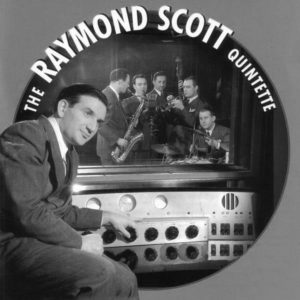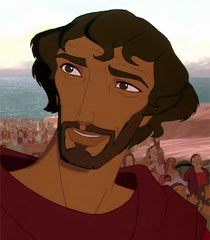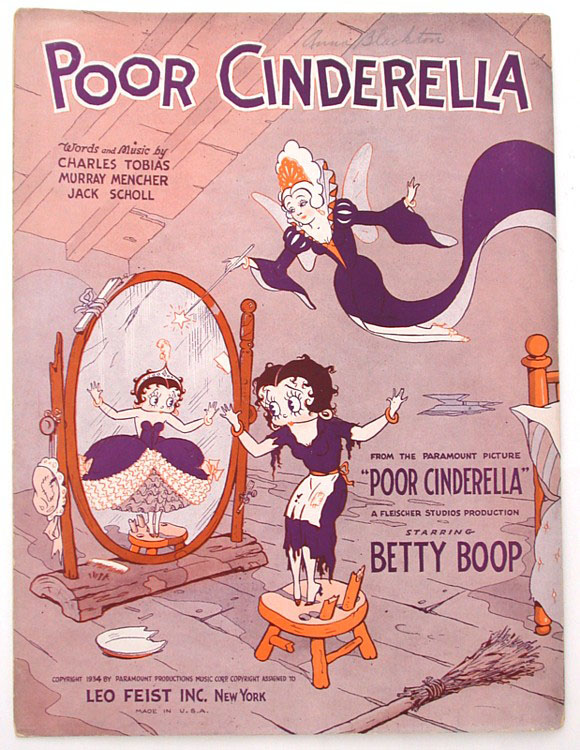 Johnny Williams and Raymond Scott. The Raymond Scott Quintet – famous for many tunes like Powerhouse that Carl Stalling sprinkled into Warner Cartoons – was always a six piece band. Scott just thought the word “quintet” had a crisp sound that he liked. The group consisted of Scott on piano, Dave Harris on tenor sax, Peter Pumiglio on clarinet and trombone, Dave Wade on trumpet, Lou Shoobe originally on bass and Johnny Williams on drums.
Johnny Williams and Raymond Scott. The Raymond Scott Quintet – famous for many tunes like Powerhouse that Carl Stalling sprinkled into Warner Cartoons – was always a six piece band. Scott just thought the word “quintet” had a crisp sound that he liked. The group consisted of Scott on piano, Dave Harris on tenor sax, Peter Pumiglio on clarinet and trombone, Dave Wade on trumpet, Lou Shoobe originally on bass and Johnny Williams on drums.
Williams was the father of composer/conductor John Williams famed for his many memorable film scores including the Star Wars, Jurassic Park, Harry Potter and Indiana Jones series among many, many other credits.
Dave Harris had lots of praise for Johnny Williams in a later interview from his North Hollywood home:
“Johnny was so perfect for the Quintet. You had to have an intelligence to know what to play – and what not to. You just couldn’t play like you would with a dance band or a jazz group. You had to fit in with the character of the tune. He was so smart – and so good – that no one ever had to tell John what to do. He was a natural.”
Williams, however was initially frustrated by Scott never using charts but composed using the Quintet itself which required endless rehearsals. Williams said, “We would work these things up and we would never change them – ever. We had to do them note for note. It was highly unsatisfactory. And after all this compulisve rehearsal, suddenly it caught on and we were making more money than anybody in town thanks to him.”
Schulz and the Great Pumpkin. After It’s the Great Pumpkin, Charlie Brown aired in 1966 where all poor Charlie got was a rock when he went out trick-or-treating, creator Charles Schulz’s office in Santa Rosa was flooded with cakes, cookies and candy all earmarked for Charlie Brown. “It was a good little story with an unusual twist,” said Schulz in L.A. Life October 30th, 1991. “I think they were the first animated group of children to actually talk to each other. They didn’t just feed each other punch lines. They said things people said. They weren’t just running into trees and things.
“Kids are mean to each other. They can be very cruel. It’s a desperate struggle on the playground to survive. If you’re small of weak, they’ll go after that. Parents don’t always remember that.”
 Tony Bancroft on Mulan. In The Boston Sunday Globe June 14th, 1998, Mulan (1998) co-director Tony Bancroft said, “It was a deliberate choice to try to keep the story as simple as possible. The nice thing about the original tale is that the components of her journey are very simple, which really gave us a chance to elaborate on her character and the characters around her. Playing off of that, it just seemed logical that we’d want to keep the visual style as simple and as graphic as possible.
Tony Bancroft on Mulan. In The Boston Sunday Globe June 14th, 1998, Mulan (1998) co-director Tony Bancroft said, “It was a deliberate choice to try to keep the story as simple as possible. The nice thing about the original tale is that the components of her journey are very simple, which really gave us a chance to elaborate on her character and the characters around her. Playing off of that, it just seemed logical that we’d want to keep the visual style as simple and as graphic as possible.
“From an artistic standpoint, Disney has to find new and different locales, new and interesting characters – different cultures, really, to try and get stories from, so that they don’t end up similar. It doesn’t work to go to the same provincial town in Europe and see some classic tale being spun. I think people want to see something different and unique as much as possible.”
 The Right Team. In Newsweek, March 30th, 1998, there was an article talking about the dozens of religious leaders that Dreamworks contacted as consultants on the animated feature Prince of Egypt (1998). “The company has reached out to everyone from Talmudic scholar Burton Visotzky to religious broadcaster Jerry Falwell. (Producer Jeffrey) Katzenberg himself called Falwell last year and asked him to put together a group of evangelical leaders to look at the film.
The Right Team. In Newsweek, March 30th, 1998, there was an article talking about the dozens of religious leaders that Dreamworks contacted as consultants on the animated feature Prince of Egypt (1998). “The company has reached out to everyone from Talmudic scholar Burton Visotzky to religious broadcaster Jerry Falwell. (Producer Jeffrey) Katzenberg himself called Falwell last year and asked him to put together a group of evangelical leaders to look at the film.
“Falwell said, ‘They have done a great job of making it enteraining yet with the kind of accuracy that is important.’ Henry Herx, film point man for the U.S. Catholic Conference was floored by the amount of time Katzenberg spent going over questions of Biblical accuracy and ethnic sensitivity.”
 Greg Daniels on King of the Hill. From the Orange County Register March 15, 1998, Greg Daniels, executive producer of King of the Hill said, “(Executive producer and creator) Mike (Judge) is wonderfully observant. He picks out the most tremendous details of character, yet he’s also kind of simple. They’re the most exact, interesting details. A style like that directs everything. So when you have sound effects, you don’t make them sound cartoony.”
Greg Daniels on King of the Hill. From the Orange County Register March 15, 1998, Greg Daniels, executive producer of King of the Hill said, “(Executive producer and creator) Mike (Judge) is wonderfully observant. He picks out the most tremendous details of character, yet he’s also kind of simple. They’re the most exact, interesting details. A style like that directs everything. So when you have sound effects, you don’t make them sound cartoony.”
“There are many temptations to make King of the Hill jokier and faster like The Simpsons or more cold and outrageous but that’s not the show. I like making a balance of emotional moments. I like being realistic. It will probably get bigger eventually because all shows tend to get bigger. It’s a very rare show that in its eighth year hasn’t gotten bigger. But I’d like to keep King of the Hill as small as possible.”
Filimation Films That Never Were. In 1988, Filmation was developing a sixty-five episode television series called Bugsburgh based on the tiny characters from their animated feature Pinocchio and the Emperor of the Night (1987). In addition they were also developing the series Sherlock Holmes in the 23rd Century and Bravo (characters who travel back in time to save the present). DIC later released a Sherlock Holmes in the 22nd Century animated series in 1999.
Filmation president and CEO Lou Scheimer said, “The market is so crowded for the Fall that we’re looking toward the year after that.” There was also talk of a series featuring the Dwarfelles from the animated feature Snow White: The Adventure Continues (released as Happily Ever After in 1990) and a feature film based on Bravestarr. At the same time as this announcement, Filmation laid off 325 employees in addition to a hundred ink and paint staff bringing the company to one-third of its original size.
Betty Boop. On the back of the Poor Cinderella (1934) sheet music, it states: “Betty Boop was sixteen years old when she was born April 1st three years ago and celebrates her sixteenth birthday every year. The mystery star of the movies will be forever young. She is the only screen star who possess eternal youth.
“Her charm and appeal is as irrestistible as that of her Hollywood sister stars. Her talents are unlimited. She can do anything any human being can do, and what is more, she can do what is humanly impossible. She can spout wings and fly like an angel or she can lift an elephant with her little finger.” Actually, Betty’s first official appearance was in Dizzy Dishes released August 9th, 1930 and not April 1st.



 Jim Korkis is an internationally respected animation historian who in recent years has devoted his attention to the many worlds of Disney. He was a columnist for a variety of animation magazines. With his former writing partner, John Cawley, he authored several animation related books including The Encyclopedia of Cartoon Superstars, How to Create Animation, Cartoon Confidential and Get Animated’s Animation Art Buyer’s Guide. He taught animation classes at the Disney Institute in Florida as well as instructing classes on acting and animation history for Disney Feature Animation: Florida.
Jim Korkis is an internationally respected animation historian who in recent years has devoted his attention to the many worlds of Disney. He was a columnist for a variety of animation magazines. With his former writing partner, John Cawley, he authored several animation related books including The Encyclopedia of Cartoon Superstars, How to Create Animation, Cartoon Confidential and Get Animated’s Animation Art Buyer’s Guide. He taught animation classes at the Disney Institute in Florida as well as instructing classes on acting and animation history for Disney Feature Animation: Florida.




















































Considering the noted birth date on that sheet music is April 1, it’s entirely possible the whole thing was intended as a joke. That would certainly be in the spirit of the early Fleischer Betty Boop cartoons.
Honestly, Filmation might’ve survived longer if it weren’t for their insistence on trying to compete with Disney in the theatrical market despite the actual visuals only getting a minor upgrade at best, though it probably didn’t help that they avoided overseas outsourcing like the plague, a noble but flawed effort that meant that there was less money to go around (after all, unlike certain other countries, the US has unions). DiC generally stayed out of the mainstream theatrical business (save a few franchise-based features early on in its life and the critical and commercial live-action disaster that was Meet the Deedles) and took heavy advantage of outsourcing, and it held on until Cookie Jar bought it out in 2008.
Steve Hulett did a whole trilogy of posts about his experiences during Filmation’s twilight years, which I definitely recommend reading yourself. Definitely puts things into perspective. http://animationguildblog.blogspot.com/search?q=filmation
They did that live-action film? Good grief. Why did they rope Disney into distributing that film? Couldn’t they give it to Columbia/Sony instead since DIC did the animated Ghostbusters series?
Nic, the reason Disney distributed DiC’s “Meet the Deedles” in 1998 is actually very simple: Disney OWNED DiC at that time. ABC purchased DiC in the early 90s, then Disney purchased ABC in the mid-90s,. This is also why Disney wound up producing an Inspector Gadget live-action film in the late 90s. DiC was owned by Disney until 2000, when Andy Heyward partnered with Bain Capital to re-aquire his studio and go independent again. (I don’t think Disney minded much.)
“April 1st three years ago” from 1934 is April 1, 1931: the precise release date of THE BUM BANDIT, Betty’s eighth appearance—and her first with a human nose (most of the time), a big forehead (most of the time), and her modern proportions. In quite a few shots, it’s the first Betty that is not in some way grotesque, even if her voice isn’t quite right.
It’s easy to see how that cartoon might have been seen as the first—even if it obviously isn’t. (Compare with A WILD HARE for Bugs Bunny, where the voice isn’t quite right either, but similarly a visible advancement over what had come before.)
Hey, great observation, David! That actually sounds like a plausible explanation… and certainly more intriguing than the date being used as a joke, as I theorized above.